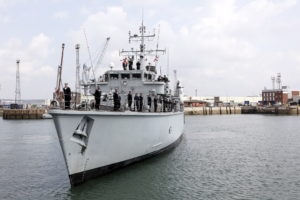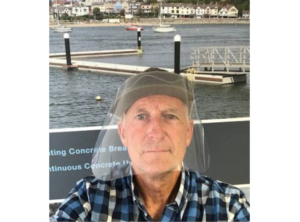Sailing ships: a catalogue of disasters
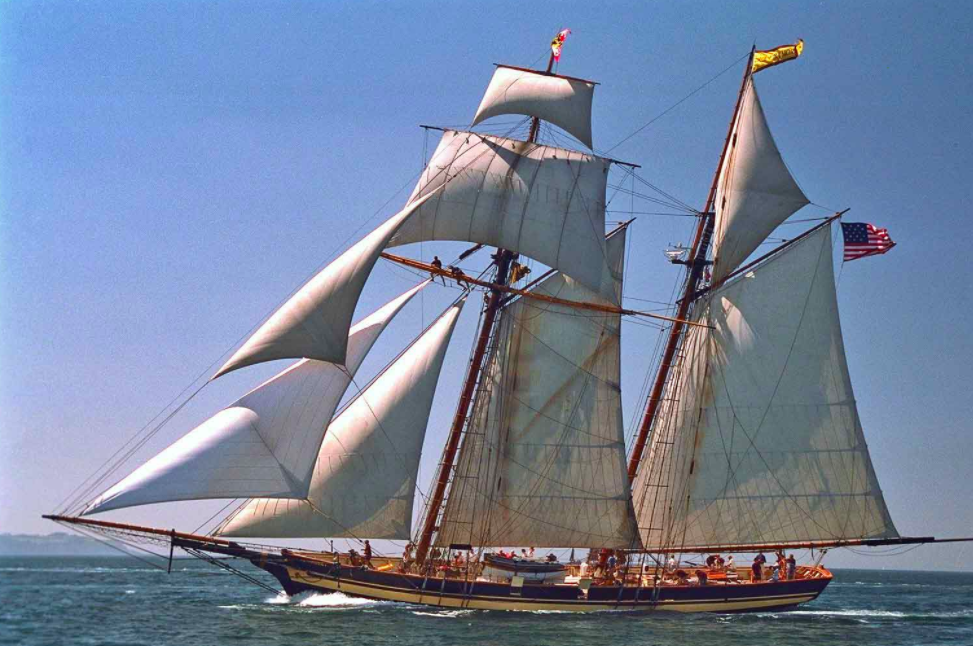
In the Skagerrak after the 2019 Tall Ships Race, the Polish brig Fryderyk Chopin suffered a partial knockdown in a squall, her yardarms in the sea. She recovered and no-one was lost or injured. Other sailing ships before her were not so fortunate, writes Peter Cardy.
In 2003 Captain Daniel S. Parrott published a detailed analysis of the loss of five sailing ships. (Tall Ships Down, Daniel S. Parrott. International Marine/McGraw-Hill 2003)
Using accident investigations, court records and the accounts of survivors he identified complex factors in the loss of each vessel.
1957: Pamir foundered, laden with barley in bulk.
1961: Albatross sank after repeated modifications to the rig and superstructure.
1984: Marques suffered a fatal knockdown.
1986: Pride of Baltimore foundered in extreme weather.
1995: Maria Asumpta was wrecked on a lee shore.
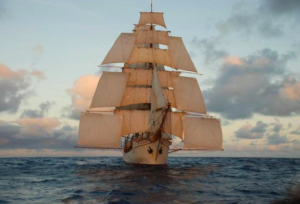
Maria Asumpta
Perhaps we have learnt from these losses but evidently some of the lessons have not been acted on. In 2009 the Polish barquentine Pogoria was dismasted after thirty years of unseen corrosion in the steel masts; in 2010 the brig Fryderyk Chopin was also dismasted. Capt Ruben de Cloux, one of the great Finnish square-rig masters, observed ‘To imagine that one knows everything, that the sea has no more to teach and the mind no more to learn, is a certain prelude to disaster.’ (Alan Villiers, Grain Race, 1933).
Everyone in command of a sailing vessel has seen the knife-edge between safety and catastrophe, starting with a trivial failure of equipment or people. There is no room for smugness in these accident reports. We weren’t there, we didn’t see the first signals. We don’t know if there were seconds or minutes in which to act but we have hindsight, while the master and crew, the actors in the spooling movie, could see only seconds or minutes ahead.
Sailing ships are deep in the psyche of maritime nations. In the UK, where coronavirus is only now reminding us that most things we rely on for everyday life come by ship, the image of a square-rigger still quickens the pulse. It is a sad but constant fact that around the world, commercial ships founder, crews drown, are burnt or blown to pieces without a flicker of interest from the media. But let a sailing ship be in trouble, especially one with a crew of young people, it will command the headlines for days. At ten years old I was gripped by the daily reporting of the Pamir, its huge casualties and handful of survivors.
Were the ten accidents in this essay avoidable? All but one of them. The rest were failures of design, seamanship, maintenance or even commonsense, but it was not known at which point the failure would become critical.
Five accidents, 1957 to 1995
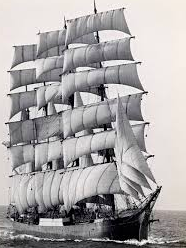
Pamir
Pamir was a four-masted barque, one of the great ‘Flying P’ bulk carriers of the House of Laeisz. She survived WWII under the New Zealand flag, and returned to German owners who aimed to reinstate her. Her final voyage in 1957 from Buenos Aires for Hamburg was as a trading schoolship with a cargo of grain.
Caught in Hurricane Carrie in the north Atlantic and thrown onto her beam ends, she quickly foundered with the loss of eighty lives and only six survivors. Most of the ship’s lifeboats found were mostly empty or awash. With no wreck and no professional seafarers surviving the cause is not known. But the decision to load barley in bulk, rather than in bags seems most likely. It can flow like a liquid creating free-surface effect. The accident ended post-war attempts at trade under sail.
Albatross was built in the Netherlands in the 1920s as a pilot schooner, designed to keep the sea in all weathers with a modest rig but oversize scantlings. She was later given a square rig and deck houses. Gear was added on deck and aloft, and with a change of engine, weight was taken out, undermining her stability.
100 miles north of Cuba in 1961, in otherwise quiet tropical weather, she was carrying almost full canvas. The main hatch was closed but in the tropics watertight doors were open. With no warning she was laid on her beam ends by a localised squall. She quickly filled through hatches and other openings. Half her complement was below at the knockdown and four died. This led to radical revision of the stability requirements for sailing ships on both sides of the Atlantic. Even so, Albatross slipped out of the public gaze until 1996 when the movie White Squall was released.
Marques, an elderly schooner was converted in the 1970s from a Mediterranean cargo-carrier to a square-rigged yacht and film platform. Later she became a three-masted barque for the recreation of Darwin’s Beagle voyage and stardom came in the 1970s TV series The Onedin Line. Deckhouses, a battery bank and a poop extension were added and mast height increased. False assumptions were made about her stability.
A UK Loadline Exemption was required for which essential data was not available but political manoeuvring eventually yielded the certificate. This enabled her to sail without watertight subdivisions, ultimately discrediting the government bodies responsible. During the 1984 Tall Ships Race off Bermuda, the Marques sank within minutes in a squall, killing 19 of her complement of 28. A court of enquiry noted among others factors, the sealing of the freeing ports (even today, all too frequent in fishing vessels) and an open cargo hatch on the maindeck for crew access.
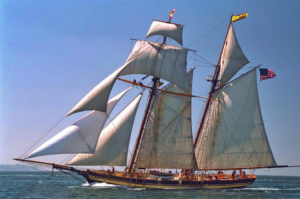
Pride of Baltimore
Pride of Baltimore was a replica of a Baltimore Clipper, a fast privateer from the American War of Independence, intended to outrun the Royal Navy blockade. The rig and design was extreme: a spectacular sailplan, heavily-raked masts, the hull narrower and deeper aft than forward. There were no watertight subdivisions and stability was not confirmed. The deck was said to flex visibly in heavy weather.
Pride was built as an exhibition ship for the city of Baltimore; she undertook tours of South America and the North Atlantic. On her return in 1986 she sank in a squall east of the Bahamas. Survivors estimated that downflooding through the one open hatch took less than five minutes. Four of her crew died: eight were rescued after four days in malfunctioning liferafts; the EPIRBs did not float free. The vessel that eventually rescued the crew was alerted by flashes from a hand mirror, the last remaining signalling device.
Maria Asumpta began life around 1858 as a transatlantic trading brig. Converted to power and derigged, she was purchased by the so-called China Clipper Society, which also owned Marques. She was rebuilt and rerigged and used for film work and sail training. She had the same Load Line certificate, revoked after the loss of the Marques, but continued in sail training through the device of a private association. In 1995 after another major structural and engineering refit she left Swansea for Padstow in north Cornwall.
Making a close pass of Rumps Point for filming and publicity she began to luff. The engines failed to start. She hit a rock and in a few minutes was smashed to fragments in full view of the spectators. Abandon ship was ordered but not co-ordinated: lifejackets were stowed below and though the life rafts inflated, they were not used. Three people died. The master was tried in court and imprisoned, a rare outcome in such cases.
Five more accidents, 2008 to 2013
Changes in regulations, resilience and manning resulted from the 1957-1995 series. But as the next five accidents reveal, the sea, the weather and human failure remained. There are some striking common strands with the earlier series.
Asgard II, an elegant wooden brigantine was purpose-designed for sail training was owned by the Irish Ministry of Defence and had a rigorous maintenance schedule. She sailed extensively in northern European waters and completed two transatlantic voyages. In 2008 she sailed from Douarnenez for La Rochelle.
In the early hours of 11 September the crew were alerted to water in the accommodation and, using all the pumps, tried unsuccessfully to stop it. A Mayday was broadcast, the sails were furled and the liferafts launched. Knowing the ship might capsize to leeward the Master ordered the crew to evacuate to the liferafts to windward.
Though one of the three liferafts failed, the entire ship’s complement was speedily rescued by the French SAR services. The float-free EPIRB did its job: ironically, shortly after the crew were landed in France, the master had a call from the Irish Coastguard to tell him the beacon was transmitting an alarm.
Underwater pictures of the wreck showed some fractures to some planking. Damage to other sailing vessels from submerged objects presumed to be shipping containers (notably the present and previous Hugo Boss Open 60 yachts) underline this possibility. On average 1,300 shipping containers are lost every year worldwide, though it is not known how many remain afloat or semi-submerged.
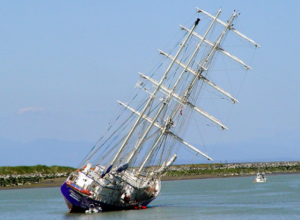
Concordia
Concordia was a seaschool barquentine registered in Barbados, owned in the Bahamas and chartered to a Canadian company. In January 2010 she was knocked down and quickly sank 300 miles off the Brazilian coast. Downflooding occurred through doors and openings on the leeward side, open for ventilation, with many of the crew in classes below.
Once horizontal in the water, the masts and rigging greatly impeded evacuation. Even so, the liferafts were successfully launched. All 64 of her complement were rescued by merchant ships only after a two-day delay by Brazilian SAR. Conditions in the liferafts, officially described as ‘challenging’ were terrible.
The Canadian investigation was disputed by the master. The report implied a lack of preparation for emergencies; the master described extensive provision. The official report implies an inadequate response to squalls; the master asserted that downbursts could not be anticipated at the time. But the design of the ship, with openings on the sides of the deckhouses rather than on the fore and aft line, placed it in jeopardy.
In 2010 Lord Rank, a 20m sail training yacht, went aground in good visibility and fine weather with light winds, on a charted pinnacle off Ballycastle, Northern Ireland. All six personnel (there were no trainees) were rescued safely.
Uncertainty about Lloyd’s Open Form meant a salvage offer was refused and the yacht became a total loss. The MCA investigation showed that though the skipper was experienced and held an RYA qualification, he did not make a passage plan nor a risk assessment, plot positions or a clearing bearing, or complete the log for this and previous voyages.
Shortly before the grounding a passenger on the helm pointed out turbulent water ahead, very likely over the pinnacle, but this was disregarded. The mate did not feel he could question the skipper’s decisions. There was little maritime knowledge at the heart of the charity, and no plan for a major incident. Communication between the vessel and head office was limited, though the incident was widely reported immediately.
The skipper was dismissed by the charity and the RYA withdrew his certificate. The UK MCA prosecuted the charity: the trustees pleaded guilty to failure to operate the vessel safely. They were given a derisory fine of £250.
In 2012 Bounty, a wooden three-masted square-rigger, sank off Cape Hatteras in Hurricane Sandy. The master and a deckhand died. The ship was built in 1960 for the film of Mutiny On The Bounty and starred in Pirates of the Caribbean and the SpongeBob SquarePants Movie.
She underwent several major refits and rebuilds, but the 2012 docking revealed extensive deficiencies that were not rectified before she sailed in October for her seasonal programme. Pumping was constant both alongside and underway, while in heavy weather the ship’s seams worked and flooding increased.
As Hurricane Sandy was developing Bounty sailed from Connecticut for Florida, making a board for unknown reasons directly into the expected hurricane track. Eventually all the engines, generators and pumps failed; she was overwhelmed and sank. The evacuation was too late and disorganised with many potential casualties; the search and rescue operation was heroic in hurricane conditions.
The report of the US Coastguard investigation is harrowing. Unlike most accident investigations, the USCG hearings were inquisitional. They blamed the Bounty Organisation for failure of oversight and the Master for negligence. Had he survived, it is likely he would have been prosecuted.
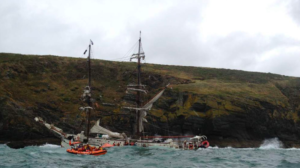
Astrid
Astrid, built in 1918, was a trading vessel; after a ‘colourful’ career, she was burnt out but re-rigged as a brig in the 1980s. She was used as a sail training vessel and a commercial yacht on the Netherlands flag.
In July 2013 she embarked trainees for a voyage from Southampton for Kinsale to join The Gathering Cruise. The owner was skippering the ship. After leaving Oysterhaven the track took the ship close inshore, where there would be good photo opportunities.
During sail handling under power, in moderate wind and seas the engines failed and the ship was driven onto the rocks. There was a bungled attempt to send a Mayday, yet the ship’s entire complement was rescued uninjured by the RNLI and the Coastguard. The ship was a total loss.
The Irish Marine Casualty Investigation Board reported that that there had been problems with water contamination of fuel in the days before the accident. This was the direct cause of the engine failure and thus the immediate cause of the grounding. The report also listed incomplete certification of the ship, its safety gear, the master and officers, along with the log book and other documents.
How risky are sailing ships?
Are sailing ships at greater risk of accidents and disasters than commercial cargo and passenger ships? There is no international definition or register and many sailing ships, even quite large vessels, appear on their national registers as ‘yachts’. It is hard to quantify serious events, partly because the total number of sailing vessels is unknown, and the culture of shipping is not to record accidents or near-misses, unlike the aviation industry.
But experienced professionals suggest that relative to their numbers worldwide (perhaps two thousand in total) the accident rate is high. Why would this be? In the 19th century sailing ship losses were so frequent that Lloyd’s did not even record the number of seafarers lost, just the ships and the masters. Until the adoption of Samuel Plimsoll’s marks, a shipowner could load a vessel far beyond safe margins with impunity: many did.
Although sailing ships have become safer as a result of regulation and technology (e.g a squall can often be seen on radar and avoided, while weather forecasting has improved immeasurably) a sailing ship remains more complex than power-driven ships. Although all are operating in the two fluids of water and air, the sailing vessel depends on their interaction and pokes its mast up into the wind and its keel down into the sea, introducing infinite variables into its passage.
Unlike the days of wooden ships, it is rarely feasible to send down steel topmasts and yards to reduce overpowering windage, nor to cut away a mast to relieve a ship on its beam ends. The master must rely on situational awareness of a thousand factors to avoid or find a way through mayhem. It is apparent when the master of a motor ship has learned their craft on sailing ships and is at ease in a multi-dimensional world. The advantages of qualifying seatime on sailing ships are obvious to most of the world’s maritime nations, but not apparently to the UK, where cadets struggle to gain acceptance. And the UK remains one of the few maritime nations without a national sailing ship, something dear to the heart of the late Colin Mudie.
Lessons from a Swiss cheese
Accident investigators talk about the Swiss cheese concept: a series of events or derelictions eats holes in the matrix, none serious enough by itself, but catastrophic when the holes line up. Are there lessons to be drawn from all these accidents, with their infinitely variable causes and outcomes?
Stability was an issue with Pamir, Albatross, Pride of Baltimore, Marques and Concordia. The connection between shifting grain, repeated modification, over-canvassing, and the placing of deckhouse openings is not obvious, but the sum of small modifications can amount to a big change. Losing track of structural and rig changes from owner to owner, and between a ship’s changing roles, can mean operators are unaware of the overall effect.
The practice in square-rigged ships encountering squalls is to bear away, ensuring that the load remains abaft the rig. Sheeting of fore-and-aft sails or the setting of an autopilot can frustrate this: Concordia, Albatross.
A strand in several accidents is what the UK Marine Accident Investigation Branch calls ‘complacency’, the belief that what has worked before will always work: Maria Assumpta, Bounty, Lord Rank. The captain must constantly interrogate the variables of sea, wind and machinery, but repetitive voyages can breed complacency, as can intimate familiarity with a vessel.
When a sailing ship is knocked down or founders there is serious danger of entanglement of people and life-saving equipment in rigging and gear: Pride of Baltimore, Maria Assumpta, Concordia and Bounty among others. Locating cutters, knives and wrenches for access at extreme angles, perhaps duplicated, anticipates this. Asgard II successfully launched the life-rafts to windward to avoid entanglement, though in stronger winds this might have been impossible.
In the sailing ship community there are skippers and owners in love with their ships and love can blind the admirer to evident shortcomings. In five accidents the skipper was the owner: Albatross, Marques, Maria Assumpta, Bounty, Astrid. The assumption that fuel contamination had been rectified when it had not was fatal to Bounty and Astrid. Posing a much-loved ship for the cameras – Maria Asumpta, Astrid – can be disastrous.
Serendipity is one element of all such events but is rarely an explanation. In only one accident was there no warning of disaster: Asgard II; there are clues but no conclusive evidence. By contrast the grounding of Lord Rank with the warning signs ignored, was clearly the result of negligence, as the trustees admitted.
Several investigations noted lack of certification of the permanent crews, Concordia, Lord Rank and Astrid among them. Though defective certificates were not cited as a cause of any of the accidents, they suggest a nonchalant attitude to compliance, especially in the cases of Lord Rank and Astrid. Certification and relevant qualifications confirm seamanship of a specific level.
Several of the vessels – Albatross, Marques, Pride of Baltimore, Concordia – suffered knockdowns in localised fierce winds variously described as wind-shear, squalls, downbursts or microbursts. These are well-recognised over centuries but apart from the general conditions giving rise to them, they are still impossible to forecast. Most frequent in tropical latitudes, they also occur in temperate waters. Like so-called ‘freak waves’ they are not freaks but normal events; usually there is no-one around to see or record them in the great expanses of the oceans.
Preparation for abandoning ship was an element in the incidents. Technology has advanced since the crew of Pamir had only open lifeboats. The evacuation of Asgard II was a textbook operation; in spite of all the other deficiencies so was the Astrid episode. But the experiences of the Albatross and Concordia crews underline the truth that taking to the liferafts remains a last, desperate measure. For a first-hand account of the grim experience of a sailing ship crew trying to survive in liferafts, see the final chapters of Sailing to the Far Horizon, Pamela Sisman Bitterman, University of Wisconsin Press, 2004.
Learning from experience
A lesson from these events is what really happens. Most sail training (and commercial passenger ship) evacuation drills assume there is time to act, the ship remains on an even keel, no-one is trapped, there is access to essential equipment. The masters and others who survived lights up the detached official accounts.
At a sail training conference survivors spoke of the consternation of waking while off watch to find water knee deep and rising. In a knockdown, bulkhead and deckhead change places. Watertight doors have to be opened against gravity and maybe the inrush of the sea. The deck of a spacious saloon becomes a vertical cliff. Tables and benches pile up to create impossible obstacles. Engines are inaccessible. Violent seas demand superhuman strength to carry out simple tasks. Domestic objects become random missiles. Liferafts can be stranded on the high side or swamped on the low side.
The captains described disorientation: seeing the rig suddenly lose its normal shape and place, replaced by a mess of rigging and mangled spars in bizarre attitudes, or the deck lying at an unbelievable angle. Each mentioned a moment of stillness, whether seconds or minutes they couldn’t say, during which they digested the new order of things. Then they went into overdrive to save their crew and maybe the vessel.
The certainty is that humans and the sea will create situations which, in detail or in general, are unforeseen. In 2013 the historic Norwegian ketch Wyvern began to take water in the Baltic. Her crew was rescued and a team from the Dutch sailing ship Wylde Swan attempted to save her. When she sank, one of the salvage team was unable to escape. Wyvern was raised and restored.
In the final trial of strength, the sea and weather win. Disaster planning for sailing ships should anticipate the unexpected, not the complacent assumptions underlying standard evacuation drills. Only a few of the major incidents involving sailing ships in the last half-century are described here, but bearing in mind the small size of the sector, some professionals consider that these cannot be described as rare or exceptional.
Sailing ships should now be carrying squall curves showing the maximum steady heel angle to prevent downflooding. Though downbursts can occur without warning, it is assumed that hatches, vents and other openings will be secured. The likelihood of increased severe weather resulting from climate change suggests that preparations should be normal, not exceptional. These might include routines for rapid depowering of square sails, instant disengagement of autopilots to enable bearing away, and more demanding evacuation rehearsals.
Openings in a ship are vulnerable, so self-closing vents and drains should be the norm, including the often-overlooked chain locker. Standing orders for closing external hatches and doorways and watertight doors need to balance ventilation and convenience, but prioritise safety. Liferafts and lifejackets are now mostly stored where they can be easily launched and donned, knowing the difficulties of evacuating a ship on its beam ends.
Gathering first-hand accounts of how an emergency unfolded is traumatic for the teller and exposes enduring psychological scars, though it is essential in preparing for future incidents. But at some point after the formal processes the masters and survivors will, if anyone asks, tell their stories for the benefit and safety of others. They do not present themselves as heroes though some of their actions have been self-evidently heroic. The brave do not know they are brave.
It would be pleasing to report that the last of these accidents was indeed the last, but it is not so. In most years since the wreck of Astrid in 2013 there has been at least one loss or serious accident involving a sailing ship in north Atlantic or European waters, not all officially reported or investigated. Sail Training International, Tall Ships America and the UK’s Association of Sail Training Organisations are organisers of tall ships events rather than regulators. They share information, anonymously if need be, and are eager to hear of accidents and what lessons are to be learned and broadcast.


